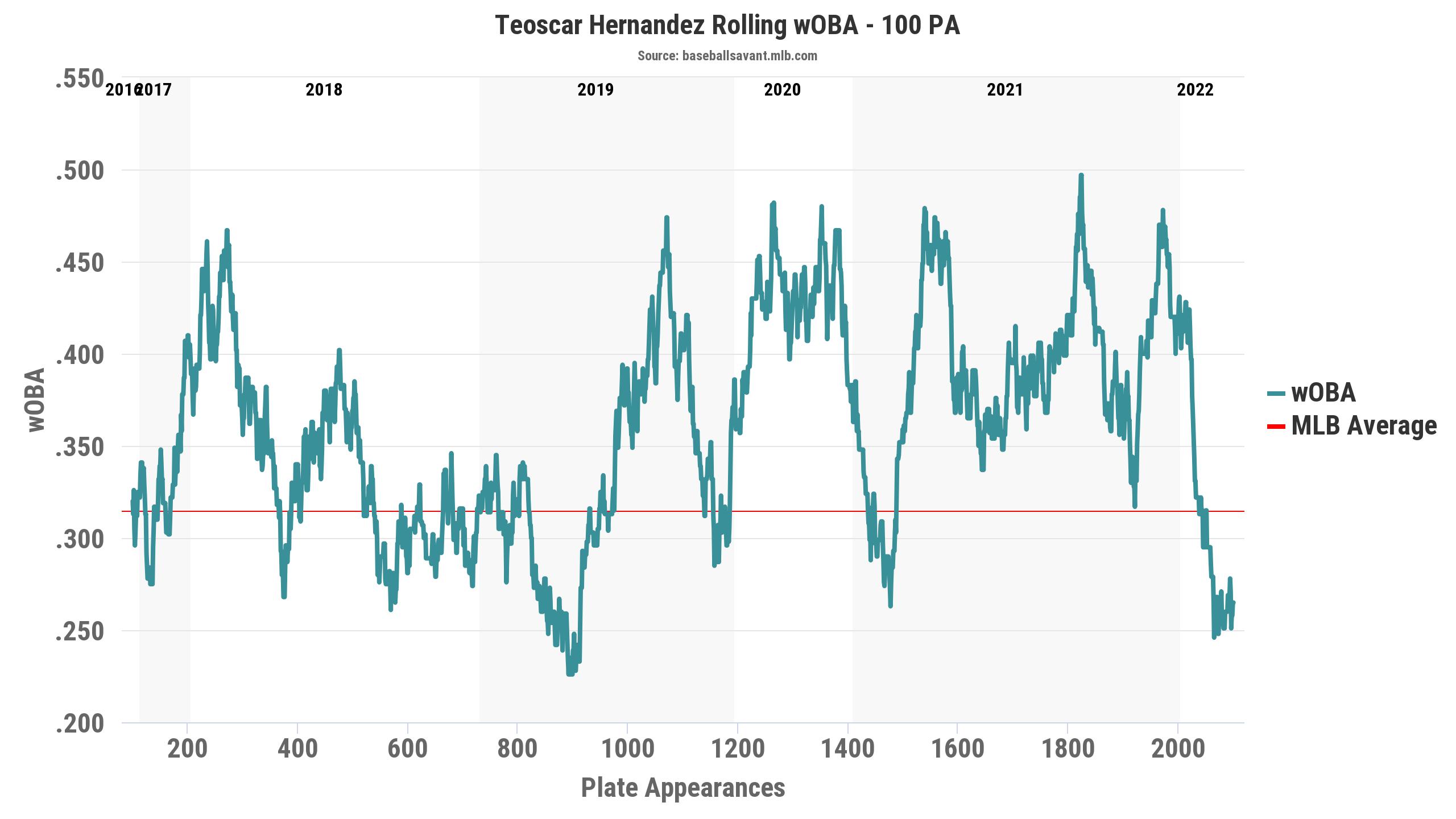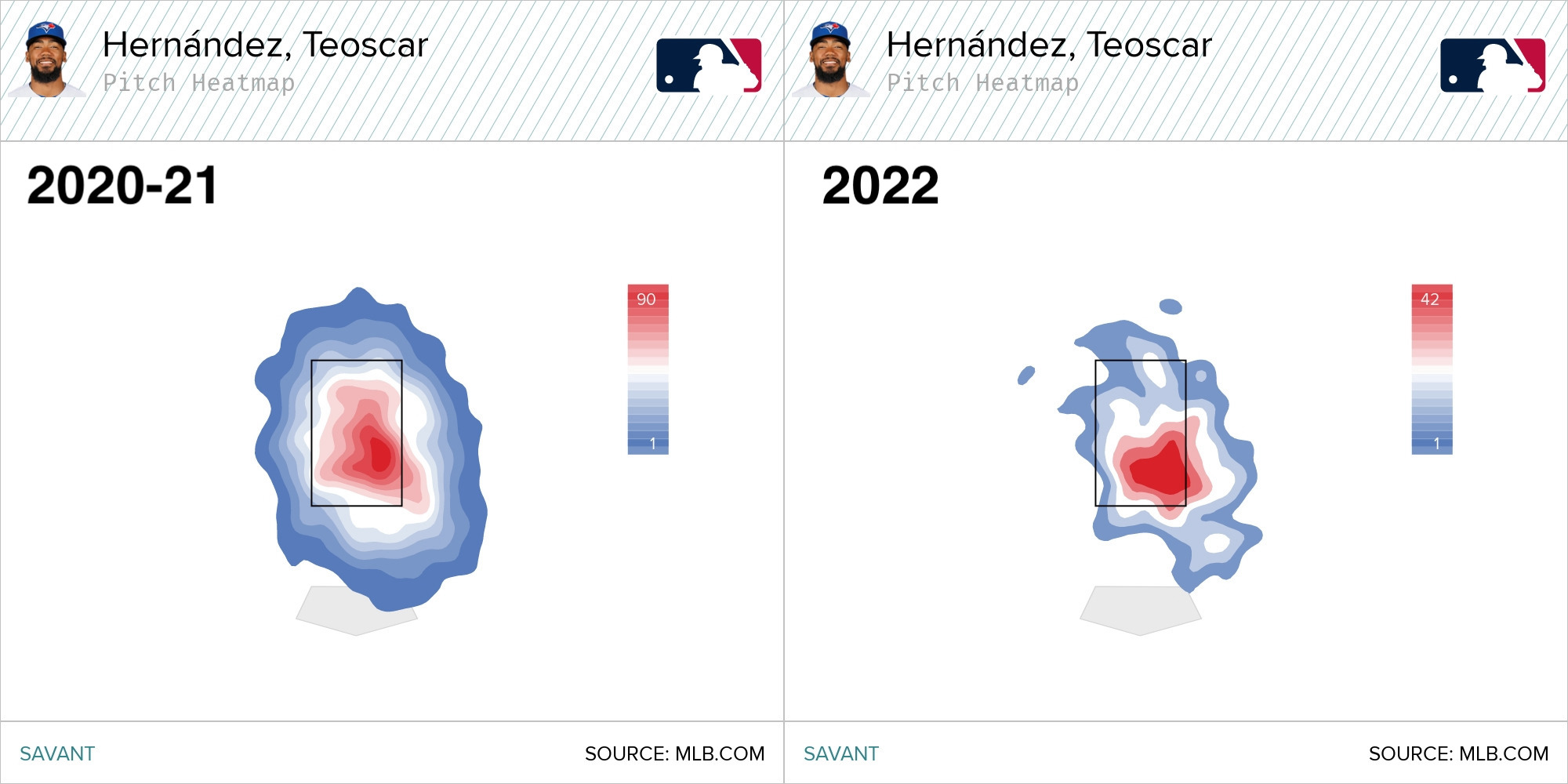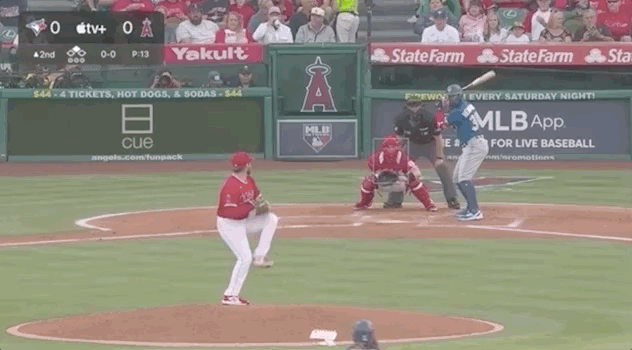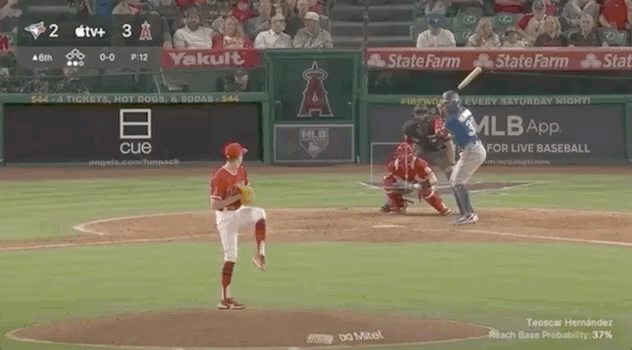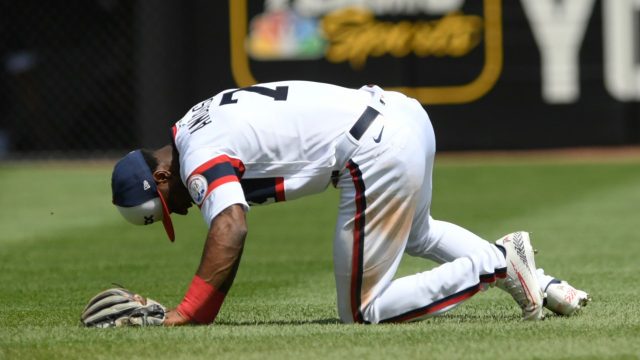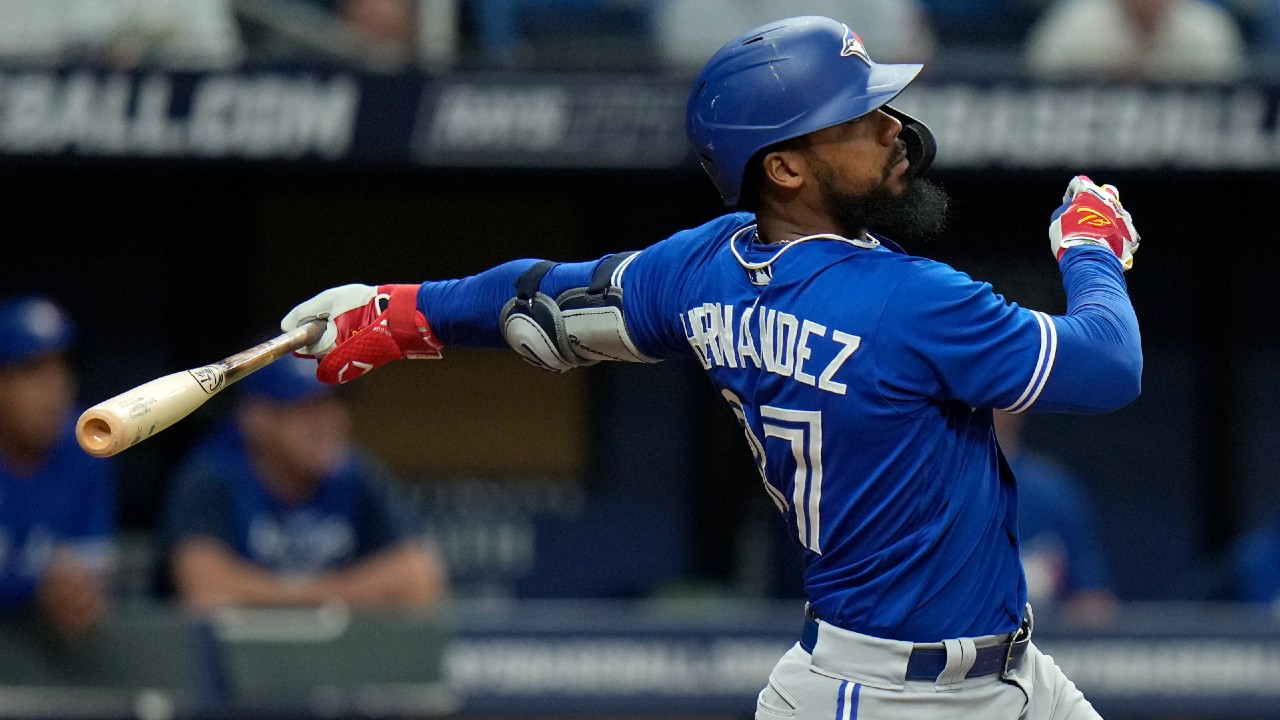
TORONTO — Over 802 plate appearances between the 2020 and 2021 seasons, Teoscar Hernandez hit .295/.345/.538 with 48 homers, good for a 134 wRC+ that ranked 15th among qualified MLB hitters. He posted a 96th percentile hard-hit rate in 2020; a 96th percentile maximum exit velocity in 2021. He was an all-star, a back-to-back Silver Slugger winner, one of the most productive hitters in the game.
Over his first 96 plate appearances of 2022, Hernandez has been… not that. He’s hitting .170/.240/.261 with only two homers. His hard contact has cratered; his groundball rate has soared. His 45 wRC+ ranks 272nd among the 279 MLB hitters to make at least 90 plate appearances so far this season. Since returning from a three-week IL stint due to a mid-April oblique strain, Hernandez is 9-for-69 — seven of them singles — with a 27.4 per cent strikeout rate.
We’ve seen Hernandez slump before, but only once has he slumped like this. It was early 2019 when he got off to a miserable .189/.262/.299 start over his first 141 plate appearances, leading to a minor-league demotion. Hernandez returned from that head-clearing triple-A stint a reformed hitter and has kept his rolling wOBA well above water most of the time over the two-and-a-half seasons since. Until now.
So, what happened? Well, that oblique injury is one possible culprit. Hernandez was out of competition for only 19 days and, upon his return, asked for an extra tune-up game at the end of a three-day rehab assignment that was only scheduled to last two.
It’s possible Hernandez is still experiencing some residual effects from that oblique strain — he was out of the Blue Jays lineup Sunday with what manager Charlie Montoyo described as a minor hip issue — which could be compromising his ability to rotate his midsection and swing the bat the way he needs to. Only he knows for sure. But there are certainly some troubling signals in his power stats that suggest he’s not generating force like he has in the past.
It’s not only that Hernandez has just two home runs over his first 96 trips to the plate. Only six of the 62 balls he’s put in play this season have travelled over 330-feet — a 9.6 per cent rate. Last season, he hit 56 balls at least 350-feet, representing 20.3 per cent of the 404 balls he put in play.
His average distance on all balls in play has plummeted from 182-feet in 2021 to 121-feet in 2022. So, he isn’t hitting balls far. And he isn’t hitting them hard, either. Hernandez has lost 1.5 miles per hour off his average exit velocity from last season. He’s yet to hit a ball harder than 109.3-mph after topping out at close to 116 each of the last two years. That’s had an expected effect on his barrel rate, which is currently less than half what it was in 2021.
|
Year |
Avg exit velo (mph) |
Max exit velo (mph) |
Barrel rate |
Avg distance (ft) |
|
2018 |
91.8 |
112.2 |
15.5% |
201 |
|
2019 |
91.2 |
112.1 |
11.7% |
191 |
|
2020 |
93.3 |
115.9 |
18.0% |
195 |
|
2021 |
91.8 |
115.7 |
13.9% |
182 |
|
2022 |
90.3 |
109.3 |
6.5% |
121 |
It’s useful to look at batted ball data like this when examining a rough start like Hernandez’s because it stabilizes fairly quickly. Hernandez’s 62 balls in play fall within the range of 50-100 it typically takes for these process-oriented stats to become reliable. At this sample size, we can’t simply brush off Hernandez’s power drop as “it’s still early” noise.
Of course, that doesn’t make it predictive of what he’ll be going forward, either. If Hernandez gets healthier or makes an adjustment to unlock the elite power he’s previously demonstrated, it wouldn’t be a surprise to see him re-achieve his prior exit velocity levels in the coming weeks. But these numbers do reliably tell us that something has compromised Hernandez’s ability to hit the ball hard to this point in the season.
And it may not be only his health. Hernandez is being pitched at dramatically differently as opponents have finally come around to the fact that feeding heaters to a guy hitting .333 with a .638 slugging percentage against fastballs over the last two seasons — MLB average was .265 with a .449 slug — might not be the greatest idea. He’s seeing fewer fastballs this season than at any point in his career; the most breaking balls, too. After two-and-a-half years of watching Hernandez steal their lunch money, MLB pitchers have adjusted.
Hernandez’s fastball rate is within the bottom nine per cent of MLB hitters while his breaking ball rate is within the top four per cent. Only 14 players are seeing a higher percentage of curveballs and sliders than Hernandez, who’s hitting .129/.156/.161 against breaking balls this season. Across MLB, pitchers are throwing fewer fastballs than ever, a counterintuitive reality in an era when the average fastball is a record 94-m.p.h. And against Hernandez, they’ve taken it to an extreme.
But it’s not only what pitchers are attacking Hernandez with — it’s where they’re attacking him. On the left is Hernandez’s heat map from the 2020 and 2021 seasons. And on the right is his heat map this year:
Down-and-away, down-and-away, down-and-away. Pitchers have always targeted that part of the zone against Hernandez, but they’re attacking it much more consistently this season — often with breaking balls — leaving very little up and over the plate. And it’s producing the intended results. Hernandez’s chase and swinging strikes rates have increased 2.5 points from last season to career highs. And his groundball rate has gone straight to the moon:
|
Year |
Chase Rate |
Swinging strike rate |
Groundball rate |
|
2018 |
28.2% |
17.8% |
36.4% |
|
2019 |
25.1% |
14.7% |
39.0% |
|
2020 |
30.9% |
15.7% |
35.9% |
|
2021 |
30.6% |
15.4% |
38.4% |
|
2022 |
33.1% |
17.9% |
59.7% |
Hernandez is either whiffing at those breaking balls down-and-away or beating them into the ground with low exit velocities. And in an era of aggressive infield shifting, it really doesn’t matter how hard you hit the ball when you’re putting it on infield grass this often. MLB defences will vacuum that contact up.
The weekend’s series in Anaheim against the Angels provided some telling examples. Here’s Hernandez’s first plate appearance Friday, when Chase Silseth started him with a pair of breaking balls down-and-away and, after the Blue Jays outfielder worked the count full, got him to hit a groundball on another one:
Hernandez actually earned a single from that plate appearance. But it’s safe to say a 70-mph groundball isn’t the kind of contact he’s looking to create. And later in that game he didn’t make contact at all, going down looking on three pitches, the final two down-and-away breaking balls from Jimmy Herget:
Hernandez saw just four fastballs that night out of 17 total pitches. Over his entire weekend in Anaheim, Hernandez saw 44 pitches — 19 of them fastballs, 21 breaking balls, and four splitters or changeups. The majority of it was down in the zone and away. He saw precious little to hit, particularly up over the plate:
That’s a frustrating diet to be fed when you’re in a slump, but that’s also the respect Hernandez’s past performance has commanded and how carefully he’s being pitched. And there were some positive indications that he’s not only well aware of the approach pitchers are taking against him, but working to counteract it.
Hernandez made strong swing decisions throughout the Angels series, swinging and missing at just five of those 44 pitches — only two of them off the plate. In Sunday’s finale, he came off the bench in the seventh inning and worked a six-pitch, bases-loaded walk against Ryan Tepera, laying off these three tough pitches down-and-away to drive in a run without swinging the bat:
Then, in the ninth, he came back up against Ryan Barraclough, worked another deep count, and finally found a way to do something with one of those down-and-away sliders:
You can see the relief on his face. It was only a softly-struck flare to no-man’s land — 78.6-mph exit velocity — but Hernandez will no doubt take it. It was hit in the air, it was off a pitch he’s had trouble with, and it was his fourth single in as many games.
Maybe those are signs he’s coming out of it. Maybe the fact he’s started only twice over the last six days has provided the break he needs to let any lingering effects of his oblique injury subside. Maybe he needed to rest, breathe, and reset mentally to start the process of getting back to being the hitter he’s been over the last two seasons and change. Because the Hernandez we’ve seen to this point hasn’t looked much like himself.


